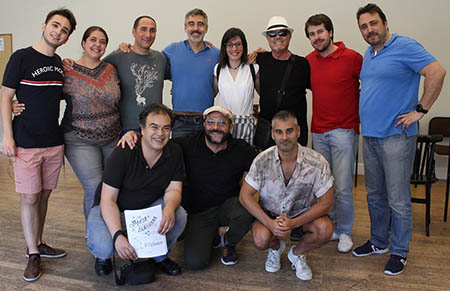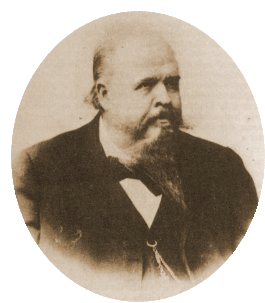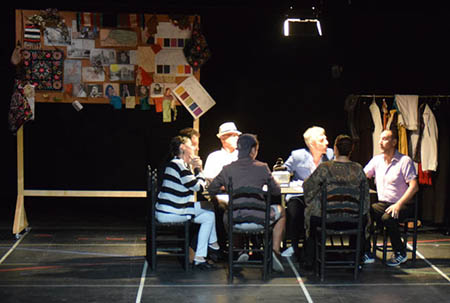
La manta zamorana
Teatro Principal de Zamora
( 29 June 2019)
Anna Tonna
On June 29 2019 I had the opportunity to be present at an extraordinary event – the revival of Manuel Fernández Caballero’s género chico zarzuela La manta zamorana. Presented by ALIZA (Asociación Lírica de Zamora), the workhad a short run on the 28-29 June at Teatro Principal de Zamora, as part of the city’s fiestas for their patron saint, San Pedro. Guillermo Perrín’s and Miguel de Palacios’s one-act libretto is set nearby the city of Zamora, at the Posada del Sayagués during those self-same festivities. At its premiere, on March 7 1902 at Madrid’s Teatro de la Zarzuela, the cast was headed by the famous tiple Lucrecia Arana, but it had not been heard in more than 90 years.
 Manuel Fernández Caballero, without doubt one of the most important and prolific composers of 19th century Spanish zarzuela, was an early champion of musical folklore. In 1902 – the same year he wrote La manta zamorana – Caballero gave a lecture to honour his induction into the Real Academia de Bellas Artes de San Fernando, entitled ‘Traditional Spanish songs are considered the indispensable element of the formation of our national music’. The melodies, orchestration and even the use of folkloric instruments in La manta zamorana are in perfect consonance with his ideas, which were intrinsic to his aesthetic concerns and compositional style.
Manuel Fernández Caballero, without doubt one of the most important and prolific composers of 19th century Spanish zarzuela, was an early champion of musical folklore. In 1902 – the same year he wrote La manta zamorana – Caballero gave a lecture to honour his induction into the Real Academia de Bellas Artes de San Fernando, entitled ‘Traditional Spanish songs are considered the indispensable element of the formation of our national music’. The melodies, orchestration and even the use of folkloric instruments in La manta zamorana are in perfect consonance with his ideas, which were intrinsic to his aesthetic concerns and compositional style.
Recently I tapped the shoulder of musicologist Enrique Mejías García, the SGAE-based musicologist, and asked his candid opinion about La manta zamorana. His detailed response included many erudite points: ‘In my opinion, in his last zarzuelas [MFC] writes music that is perhaps his most beautiful, the most pure and theatrical género chico works from the end of the 19th century, with titles that unfortunately today are barely known – with the exception of La viejecita and Gigantes y cabezudos. I speak of genuine, forgotten masterworks such as El padrino de el Nene and El señor Joaquín, both to librettos by Julián Romea. At the end of the 1890’s, Caballero wrote a group of lyric theatre titles that can be considered truly genuine Spanish ‘micro operas’, very much on a par with the grand successes of Chapí and La verbena de la Paloma at Teatro Apolo. La manta zamorana – as well as El traje de luces – are at this level of quality. We cannot truly evaluate these works until they are seen and heard in revivals and recordings.’
***
The project of reviving La manta zamorana in a semi-staged version for ALIZA was led by the soprano/producer Conchi Moyano. She was joined by the conductor José Luis López Antón and stage director Curro Carreres, in collaboration with the Joven Orquesta Sinfónica de Zamora, La Banda Municipal de Zamora, Coro ALIZA and the Asociación Etnográfica Don Sancho, which provided original regional, folkloric costumes for the production. The new critical edition of the score, by the conductor Juan de Udaeta, was specially commissioned for this revival by SGAE.

Despite the revival being promoted as semi-staged, Curro Carreres theatrical vision was fully fleshed out and choreographed, as witnessed by his nuanced staging of the complex first scene, which ends with a quartet sung by the four main characters. A modern-day prologue by Pedro Villoria preceded the action; and the production was fully costumed in authentic and historical regional dress, giving the sense of a tableaux vivant straight out of a Joaquin Sorolla painting. This effect was complemented by the ballet sequence, where the (locally-based) dancers were accompanied – as Caballero requested – by a tamborilero (the nationally-celebrated Luis Pedraza), folkloric flute in one hand, drum in the other, to emphasise the work’s regional flavour.
 As the heroine María Juana, Conchi Moyano sang with clarion clarity, easily overcoming any difficulties posed by the tiple range, half mezzo and half soprano; despite the depth of the role’s lower tessitura her top A’s above the stave were of great brilliance. Baritone José Julián Frontal played the central role of Juan Manuel, ‘El zamorano’: exhibiting great nobility on stage, he also sang with great beauty of tone. His partnership with Moyano in their extended dúo was one of the highlights of the evening. Countertenor Nacho Castellanos as El Jorobadico contributed an impassioned ‘Jota y canción’. Mezzo-soprano Adriana Viñuela sang the ‘heroine’s best friend’ role effectively. Darío Gallego as the hero’s rival displayed an attractive baritone voice. Both Keke Resalt as Ramón, and Aurelio Puente as the somewhat sinister town peddler José, proved excellent actor singers with ample experience in the genre. The young conductor José Luis López Antón, one of the coming names on the Spanish orchestral scene, efficiently led his two orchestras of local, young players.
As the heroine María Juana, Conchi Moyano sang with clarion clarity, easily overcoming any difficulties posed by the tiple range, half mezzo and half soprano; despite the depth of the role’s lower tessitura her top A’s above the stave were of great brilliance. Baritone José Julián Frontal played the central role of Juan Manuel, ‘El zamorano’: exhibiting great nobility on stage, he also sang with great beauty of tone. His partnership with Moyano in their extended dúo was one of the highlights of the evening. Countertenor Nacho Castellanos as El Jorobadico contributed an impassioned ‘Jota y canción’. Mezzo-soprano Adriana Viñuela sang the ‘heroine’s best friend’ role effectively. Darío Gallego as the hero’s rival displayed an attractive baritone voice. Both Keke Resalt as Ramón, and Aurelio Puente as the somewhat sinister town peddler José, proved excellent actor singers with ample experience in the genre. The young conductor José Luis López Antón, one of the coming names on the Spanish orchestral scene, efficiently led his two orchestras of local, young players.
Despite Caballero’s fount of inspiration being the traditional songs of Spain, in Mejías García’s opinion ‘Caballero’s scores never become mere folkloric suites; on the contrary, in late works such as La inclusera or El abuelito we can discern that the composer is married to what’s best in the bel canto tradition. His romanzas, dúos, concertante ensembles are composed with techniques that perhaps encroach on operatic territory, but in Caballero’s hands they are fed from popular sources, that in the theatre resonate in a very personal manner. Caballero always sounds like Caballero. We can only hope that we will not have to wait long to see this piece done in Madrid, or that it gets recorded along with the other titles I’ve mentioned – as they are without a doubt, authentic works of beauty, at the best level of the Hispanic tradition of music-theatre’.
© Anna Tonna and zarzuela.net, 2019
![]() Manuel Fernández Caballero
Manuel Fernández Caballero
![]() homepage - zarzuela.net
homepage - zarzuela.net
4/XI/2019